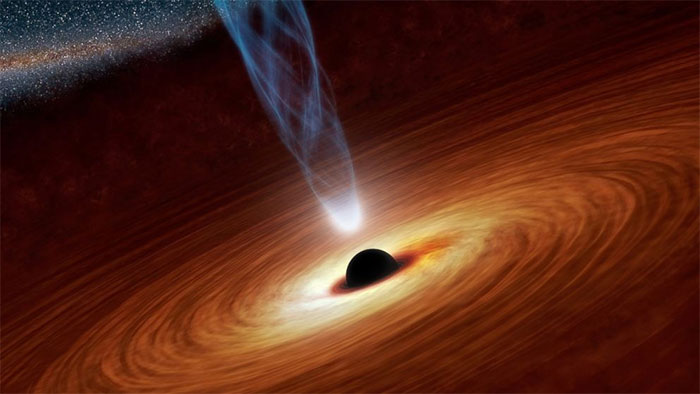New discovery of the oldest black hole in the universe
Research published on January 17 in the scientific journal Nature has revealed interesting findings about the history of the formation of the oldest black hole in the universe.

This illustration released by NASA on February 21, 2013 shows a supermassive black hole in the spiral galaxy NGC 1365. (Illustration: AP)
Previously, based on images observed by the James Webb telescope, scientists believed that this black hole has a mass 1.6 million times that of the Sun. It resides at the center of the ancient galaxy GN-z11 and was born just 430 million years after the Big Bang that formed the universe, which is 200 million years longer than any black hole ever observed. This black hole also possesses characteristics similar to other black holes, being invisible and only detected by giant bursts of light when the black hole 'swallows' all surrounding matter.
Interestingly, this black hole goes against conventional wisdom, which has held that supermassive black holes at the centers of galaxies take hundreds of millions, or even billions, of years to form. However, study co-author Stephane Charlot, an astrophysicist at the French Institute of Astrophysics in Paris, suggests that black holes in the early universe may have formed differently than those closer to them.
One hypothesis suggests that the birth of the black hole at the center of the galaxy GN-z11 comes from the explosion of a series of massive stars that only existed in the early universe, or the direct collapse of a dense gas cloud that has not yet entered the star-forming stage. Once born, the black hole will continue to absorb the abundant surrounding gas to continue growing.
Cambridge University astronomer Jan Scholtz - co-author of the study - expects that the James Webb telescope and many other devices, typically the European Space Agency's (ESA) Euclid telescope, will discover more similar black holes.
- Discover the mystery of the most exotic black holes in the universe
- Detecting huge black holes revealing the universe at the age of cradle
- Black force - a new force in the universe, becomes even more strange
- 740 million light years away is a completely different universe of black holes
- Super-large black hole rotates rapidly near the speed of light
- The most outstanding cosmic discoveries in 2010
- The mystery of the origin of the universe: Can each black hole give birth to a baby universe and do we live in a black hole?
- Video: Top 5 biggest black holes discovered by NASA in 2017
- No one expected, there were these weird black holes
- Science warns super giant black holes that can
- Unexpected discovery: Rain occurs in cosmic black hole
- The supermassive black hole was discovered 34 billion times larger than the Sun.
 Van Allen's belt and evidence that the Apollo 11 mission to the Moon was myth
Van Allen's belt and evidence that the Apollo 11 mission to the Moon was myth The levels of civilization in the universe (Kardashev scale)
The levels of civilization in the universe (Kardashev scale) Today Mars, the sun and the Earth are aligned
Today Mars, the sun and the Earth are aligned The Amazon owner announced a secret plan to build a space base for thousands of people
The Amazon owner announced a secret plan to build a space base for thousands of people The nearest black hole discovered is only 150 light years from Earth
The nearest black hole discovered is only 150 light years from Earth  The Black Pyramid and the tragedy of deep oblivion: A thousand years later, still no escape from the tragedy of tomb raiding
The Black Pyramid and the tragedy of deep oblivion: A thousand years later, still no escape from the tragedy of tomb raiding  Exploring the 'Black Box of the Earth' project: A device that records the process of human extinction
Exploring the 'Black Box of the Earth' project: A device that records the process of human extinction  Finding the mysterious 'monster' that is making the universe expand
Finding the mysterious 'monster' that is making the universe expand  Why do images of black holes appear to be burning from the outside?
Why do images of black holes appear to be burning from the outside?  Image discovered recording a black hole jet colliding with a mysterious object
Image discovered recording a black hole jet colliding with a mysterious object 